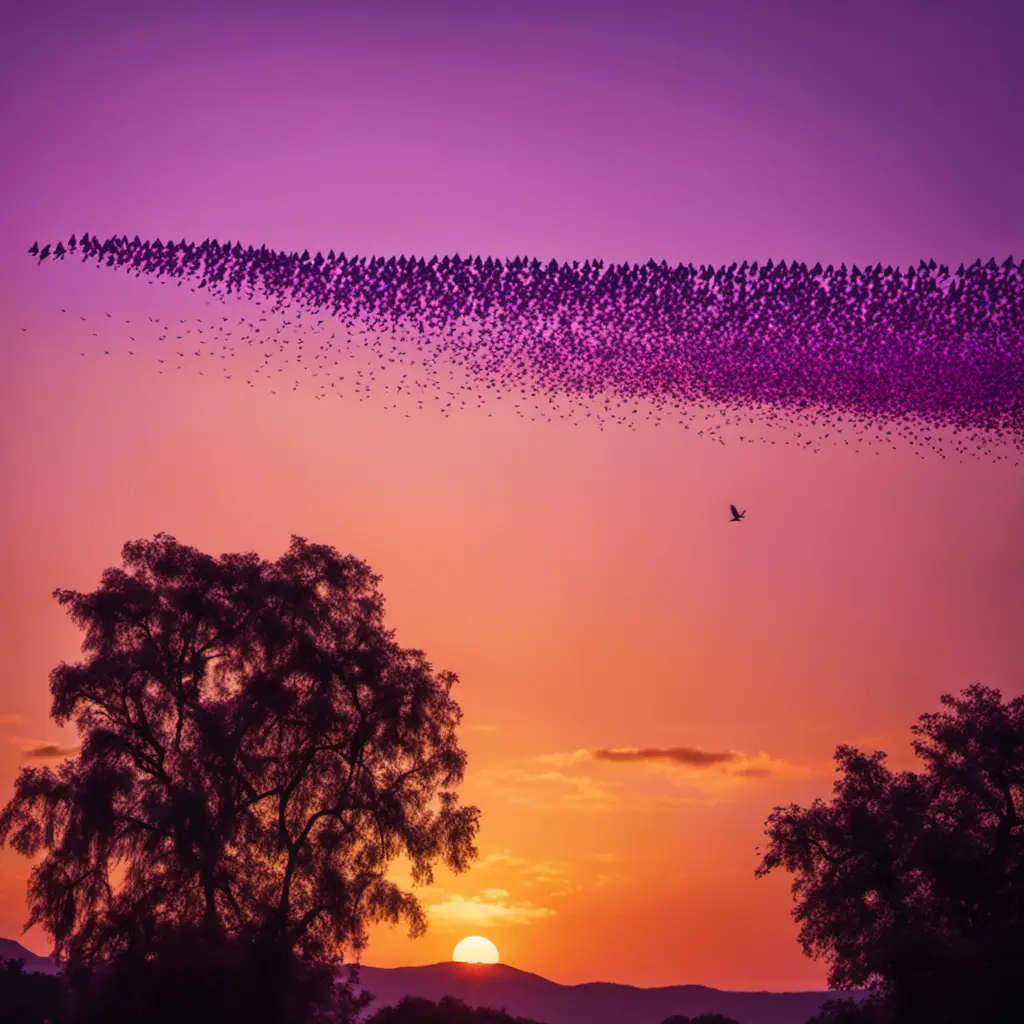Purple birds are a captivating group of avian species known for their vibrant plumage. This article explores the diversity of purple birds, including the Purple Martin, Purple Honeycreeper, Violet-backed Starling, Purple-breasted Cotinga, Purple Gallinule, Purple-naped Lory, Purple-bibbed Whitetip, Purple-headed Lorikeet, and Purple-bellied Parrotlet.
Through a scientific lens, we delve into their unique characteristics, habitats, and behaviors. This objective overview aims to provide a comprehensive understanding of these fascinating creatures for an audience interested in avian biology and appreciation.
Key Takeaways
- The population of Purple Martin birds has significantly increased in recent years due to conservation efforts and understanding of migration patterns.
- Purple Honeycreepers play a vital ecological role as seed dispersers and pollinators, but they face threats such as habitat loss and fragmentation.
- Violet-backed Starlings have stunning iridescent plumage and undertake long-distance migrations. They are monogamous and both parents participate in feeding and caring for the chicks.
- The Purple-breasted Cotinga is a neotropical bird species that has been declining due to habitat loss and illegal hunting. Understanding its mating dance can provide insights into reproductive biology.
Purple Martin
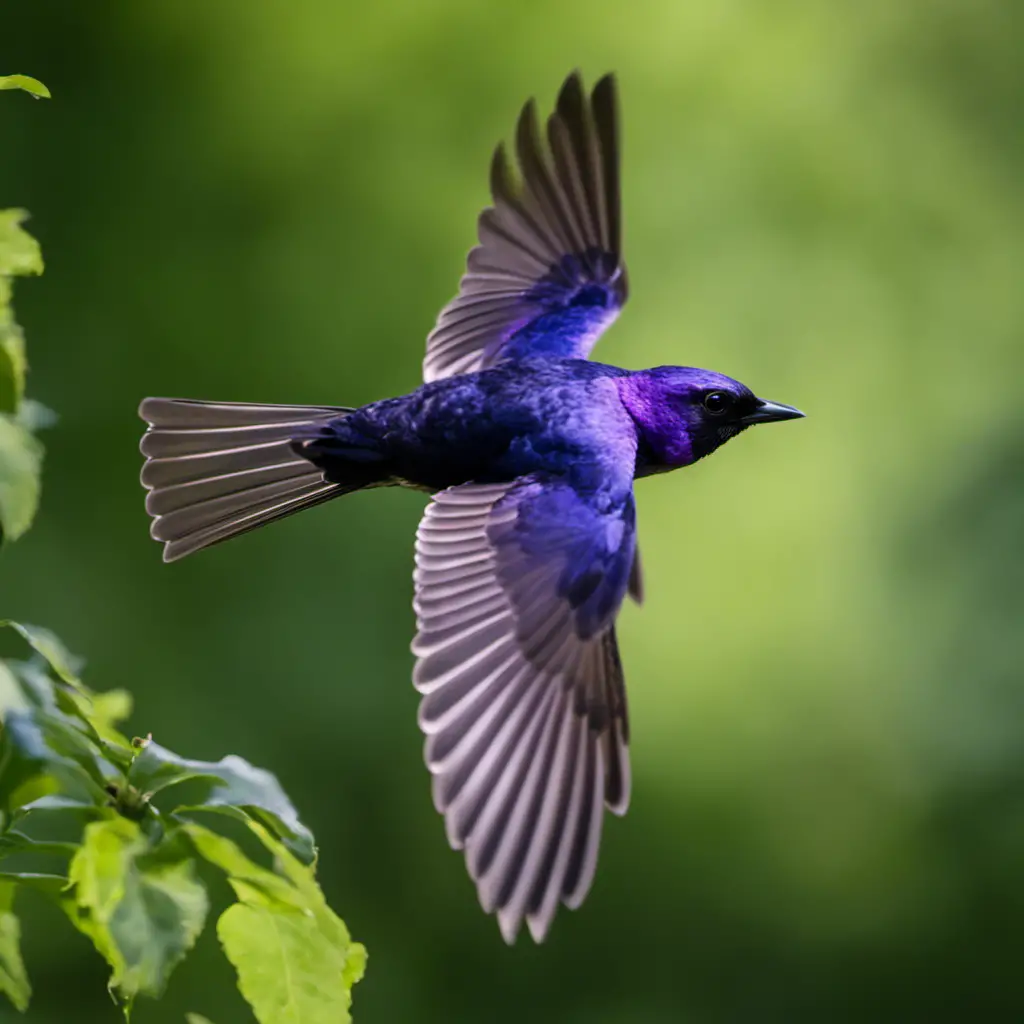
The population of Purple Martin birds has significantly increased in recent years, with a notable rise in the number of breeding pairs observed in various regions. This increase can be attributed to several factors, including the conservation efforts focused on the species and the understanding of their migration patterns.
Purple Martins are known for their long-distance migration, traveling from their breeding grounds in North America to their wintering grounds in South America. These birds rely on specific habitats along their migration route, including roosting sites and suitable breeding areas. Conservation efforts have focused on preserving these habitats, providing nesting boxes, and reducing the use of harmful pesticides that can affect their food sources.
The increase in Purple Martin populations is a positive sign for the species’ conservation. It indicates that the efforts to protect their habitats and raise awareness about their migration patterns have been successful. Continued conservation efforts are essential to ensure the long-term survival of these magnificent birds and their important role in the ecosystem.
Purple Honeycreeper
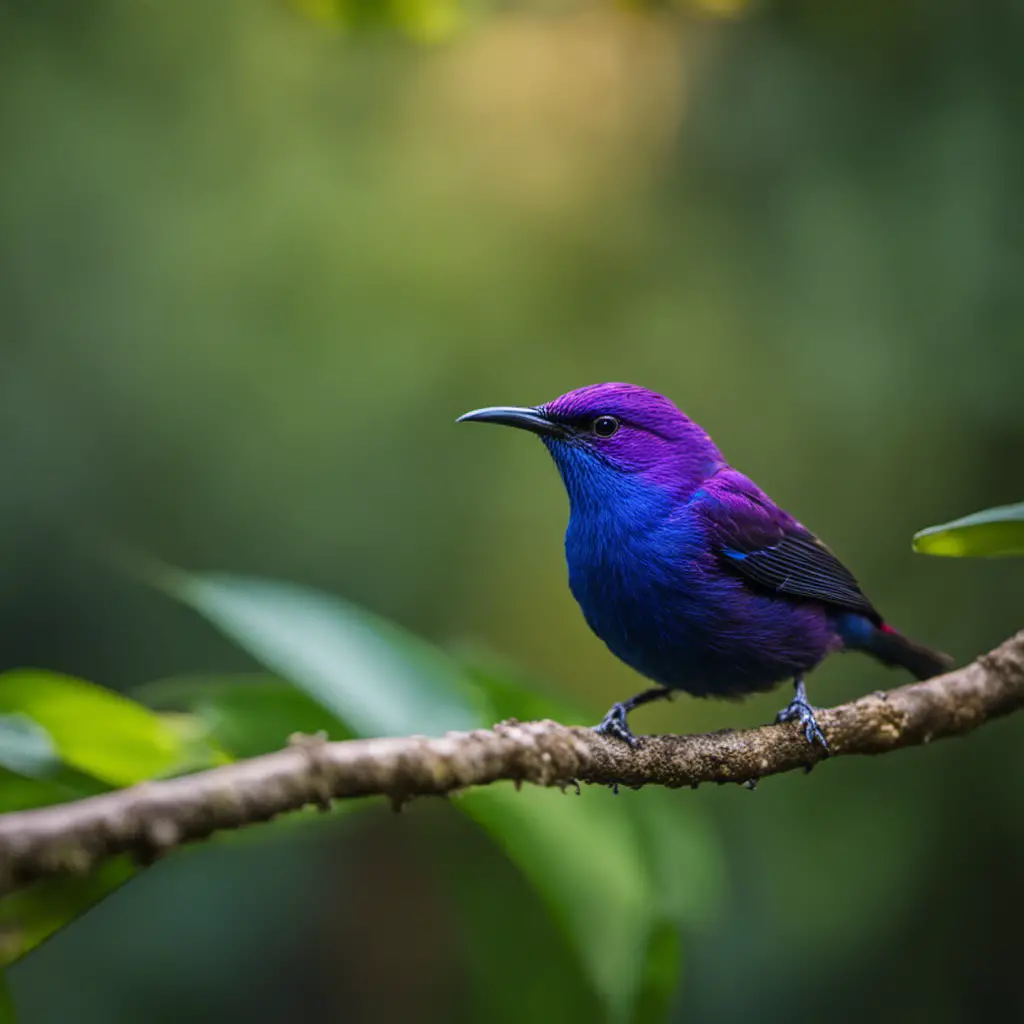
An interesting fact about Purple Honeycreepers is that they exhibit sexual dimorphism, with the males displaying vibrant purple plumage while the females have a more muted greenish-brown coloration.
These stunning birds are native to the tropical rainforests of Central and South America.
Purple Honeycreepers play a vital ecological role as seed dispersers, feeding on fruits and flowers and spreading seeds throughout their habitat. They also contribute to pollination by feeding on nectar from flowering plants.
However, these birds face numerous threats, including habitat loss and fragmentation due to deforestation and urbanization.
Conservation efforts are being implemented to protect their habitats and raise awareness about their importance. These efforts include creating protected areas, promoting sustainable land use practices, and educating local communities about the value of conserving the Purple Honeycreeper and its unique behaviors.
Violet-backed Starling
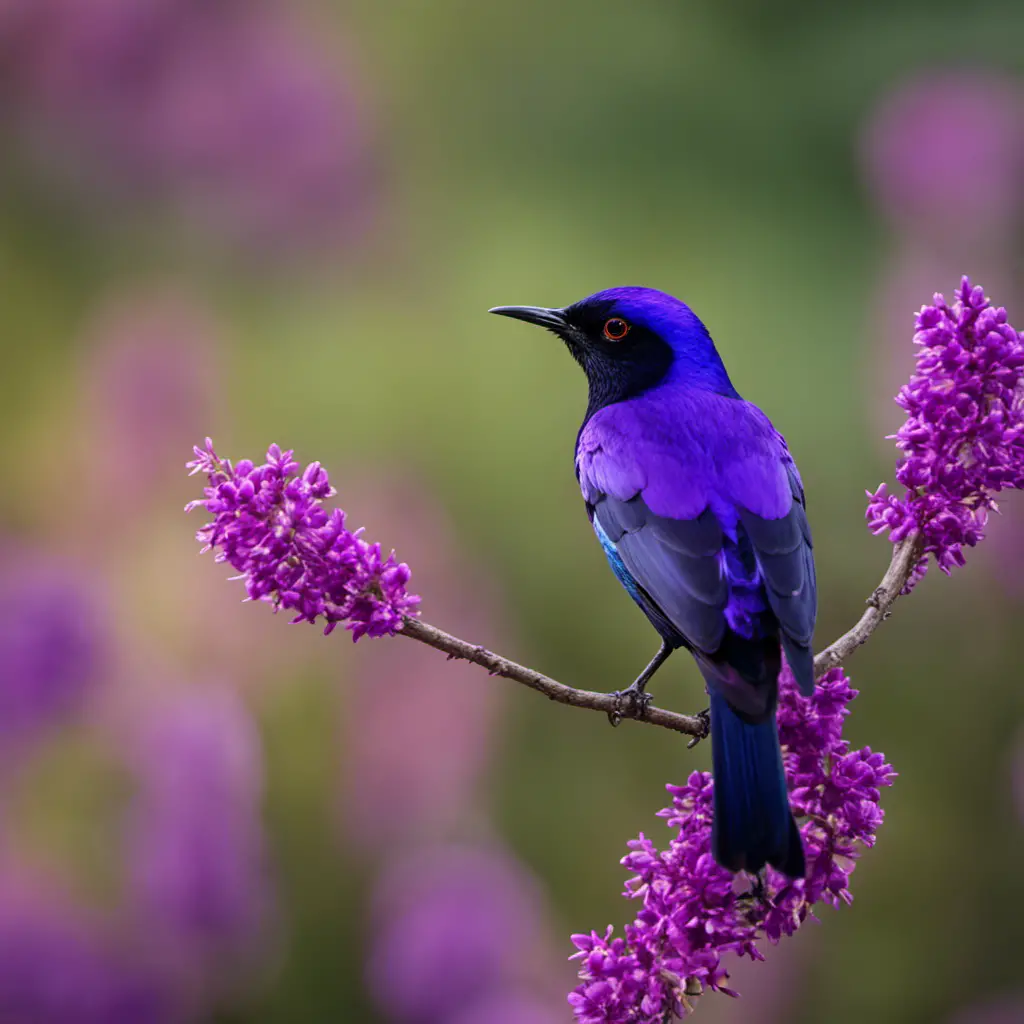
Violet-backed Starlings are known for their stunning iridescent plumage and their ability to mimic the songs of other bird species. These birds have a vibrant violet-blue back, contrasting with their black head, wings, and tail. Here are some key aspects of their habitat, migration patterns, breeding behavior, and parental care:
Habitat and Migration Patterns:
Violet-backed Starlings are native to sub-Saharan Africa, particularly in woodland and savannah habitats.
They are migratory birds and undertake long-distance migrations between their breeding and non-breeding grounds.
During the breeding season, they can be found in the southern parts of their range, and during the non-breeding season, they migrate further north.
Breeding Behavior:
Violet-backed Starlings are monogamous and form pair bonds during the breeding season.
They build cup-shaped nests made of twigs, grass, and leaves, usually in tree cavities or thick vegetation.
The female lays 2-4 eggs, and both parents take turns incubating them for about 13-15 days.
Parental Care:
Both parents participate in feeding and caring for the chicks once they hatch.
The chicks are altricial, meaning they are born naked and helpless, requiring constant parental care.
The parents feed the chicks a diet consisting of insects, fruits, and nectar until they are ready to fledge, which usually occurs around 21-23 days after hatching.
Purple-breasted Cotinga
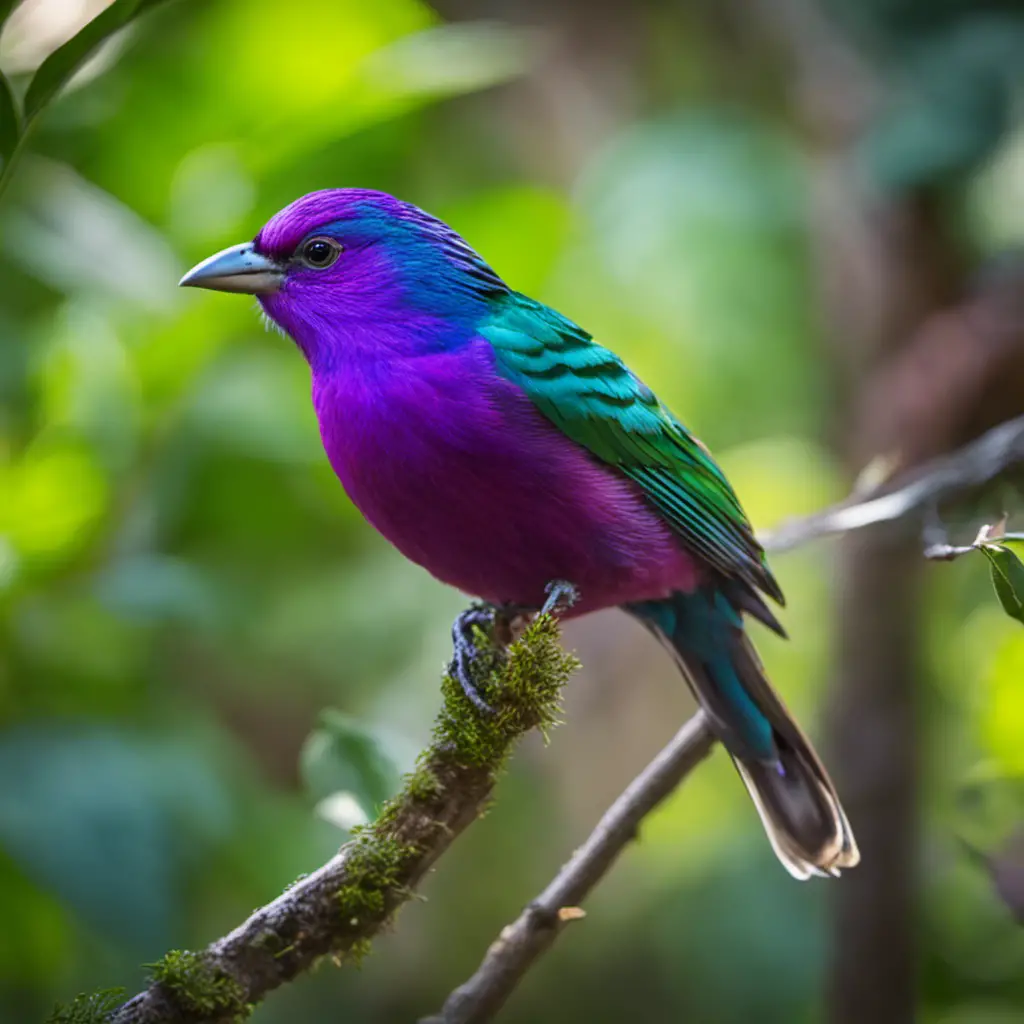
A few species of purple-breasted cotinga are recognized for their vivid plumage, making them highly sought after by birdwatchers and researchers alike. The purple-breasted cotinga (Cotinga cotinga) is a neotropical bird species found in the tropical rainforests of Central and South America. This bird is considered a symbol of conservation efforts, as its population has been declining due to habitat loss and illegal hunting.
The purple-breasted cotinga is known for its unique mating dance, which is a spectacle to behold. During courtship, the male cotinga performs a series of elaborate movements, including wing flapping, tail spreading, and vocalizations. This display is intended to attract a female mate and establish dominance over rival males. Researchers have observed that the intensity and duration of the mating dance can vary among individuals, indicating potential differences in genetic fitness.
Understanding the intricacies of this unique behavior can provide valuable insights into the species’ reproductive biology and aid in its conservation efforts.
Purple Gallinule
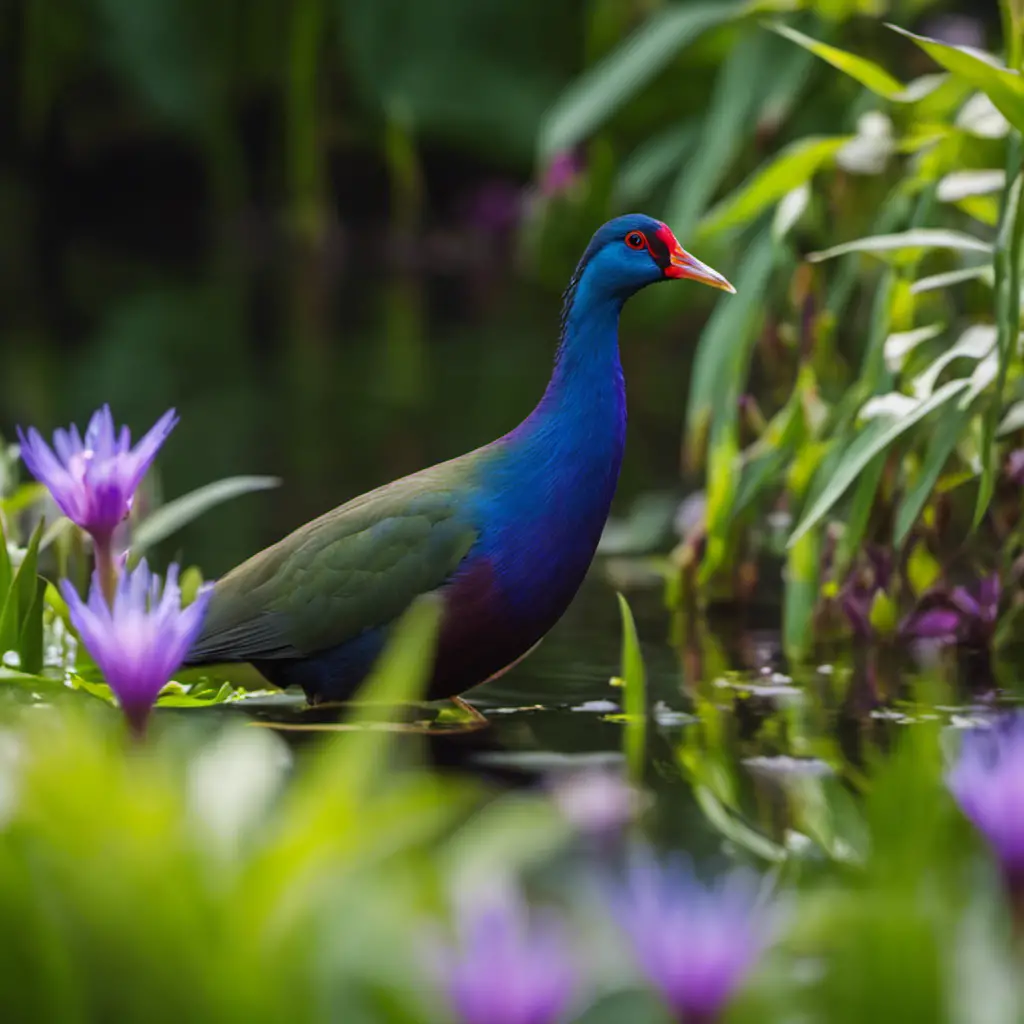
Three subspecies of the Purple Gallinule are recognized, each with its own unique range and characteristics. The Purple Gallinule (Porphyrio martinicus) is a colorful bird species found in wetland habitats across the Americas. It is known for its vibrant purple-blue plumage, bright yellow legs, and red bill. The three subspecies are the American Purple Gallinule (P. martinicus martinicus), the Mexican Purple Gallinule (P. martinicus cyanopus), and the Caribbean Purple Gallinule (P. martinicus bloxami).
The American Purple Gallinule can be found in the southeastern United States and the Caribbean.
The Mexican Purple Gallinule is found in Mexico and Central America.
The Caribbean Purple Gallinule is restricted to the Caribbean islands.
Purple Gallinules are highly adapted to their wetland habitats, where they forage for aquatic plants, insects, and small invertebrates. They are known for their unique behavior of walking on floating vegetation and are skilled swimmers. They are also known for their loud and distinctive calls, which they use for territorial defense and communication.
Purple Grenadier
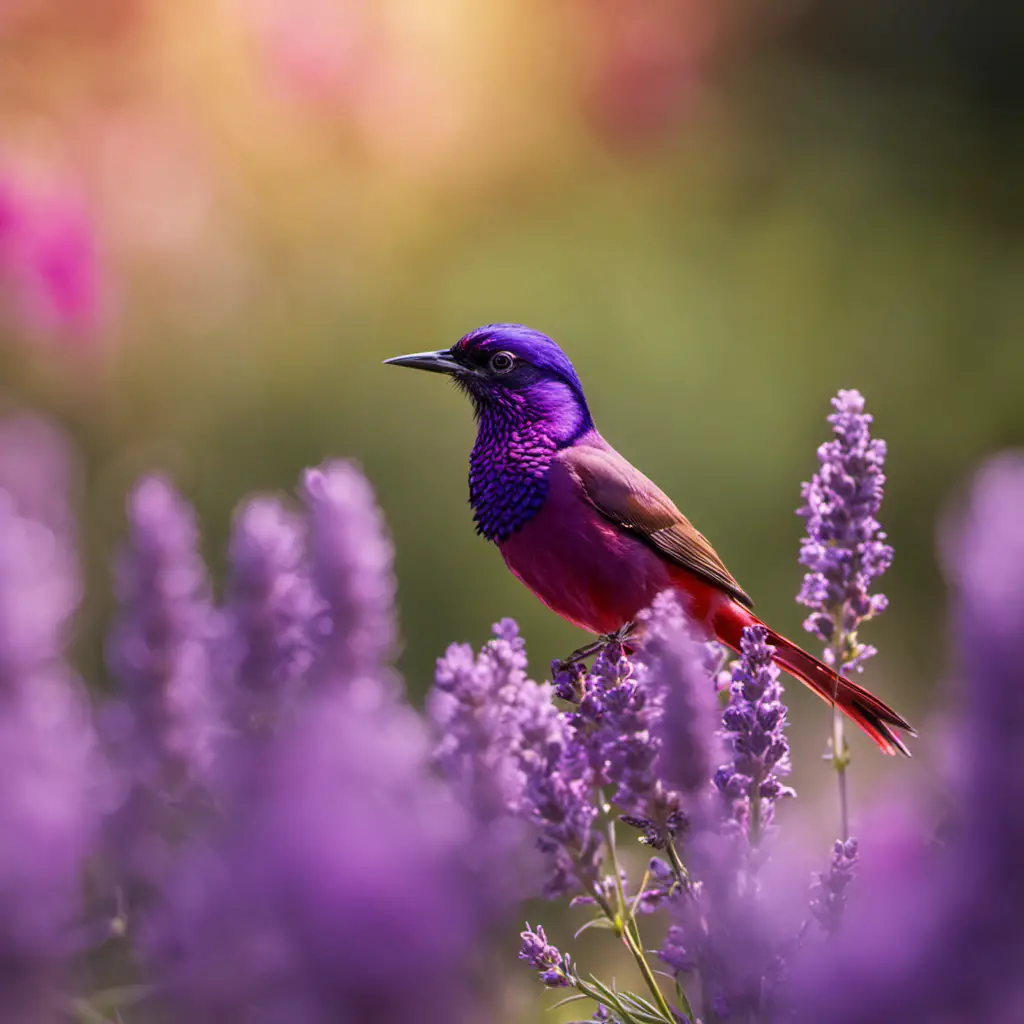
The Purple Grenadier is a small finch-like bird that is native to sub-Saharan Africa and is known for its striking plumage and vibrant purple coloration. This bird is highly sought after by bird enthusiasts due to its unique appearance.
The breeding habits of the Purple Grenadier are quite interesting. They typically form monogamous pairs during the breeding season and construct small cup-shaped nests made of plant fibers and spider webs. The female lays a clutch of 3-4 eggs, which are incubated by both parents for about 12-14 days.
Once hatched, the parents feed the chicks a diet consisting mainly of seeds, insects, and small fruits. The feeding behavior of the Purple Grenadier is primarily granivorous, meaning they primarily consume seeds. They are also known to forage on the ground and in low vegetation, using their slender beak to extract seeds from grasses and small fruits.
Overall, the Purple Grenadier is an interesting bird species with unique breeding habits and feeding behavior.
Purple Swamphen
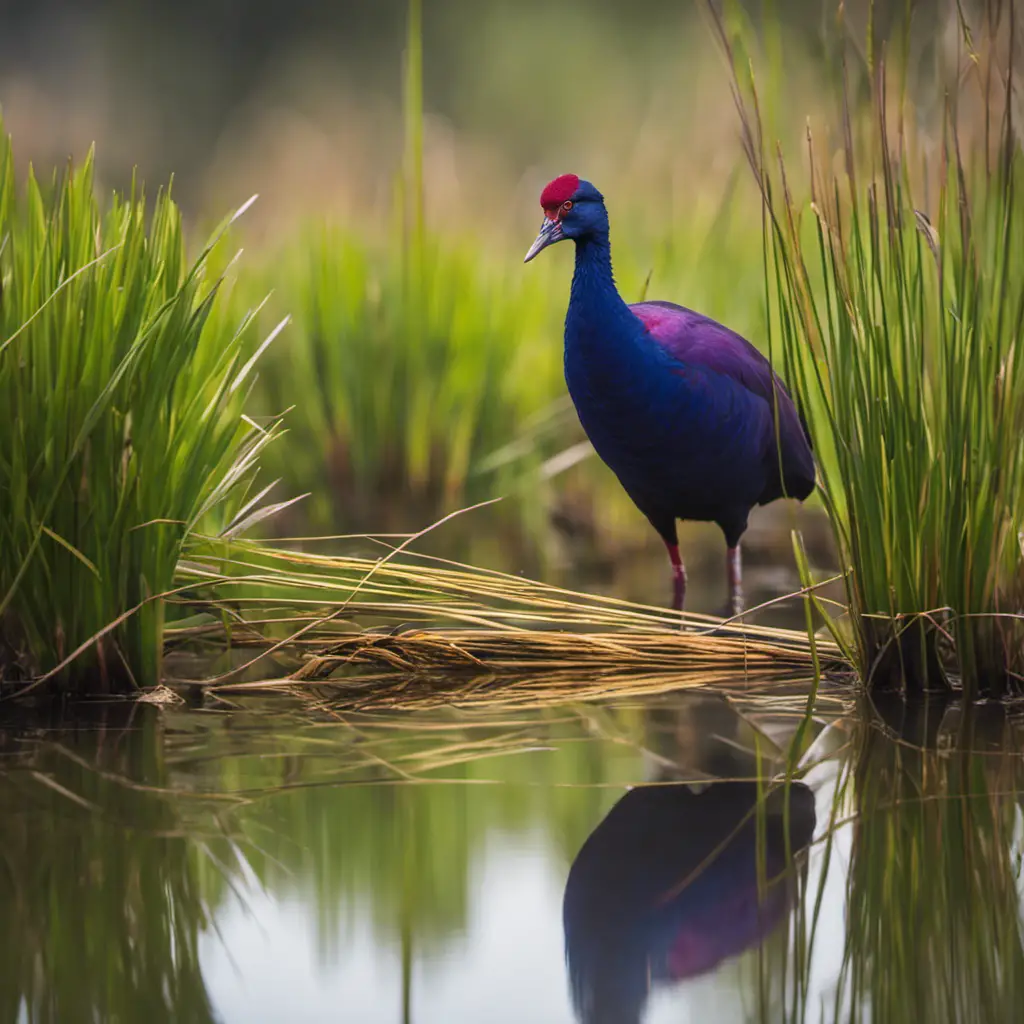
Although the Purple Swamphen is often mistaken for the Purple Grenadier due to their similar vibrant purple coloration, they are actually two distinct bird species with different breeding habits and feeding behavior.
The Purple Swamphen, also known as the Purple Gallinule, is a large bird that is native to wetland habitats in parts of Europe, Asia, and Africa. It is known for its striking purple plumage, red bill and frontal shield, and long legs. This species is highly adaptable and can be found in a variety of wetland habitats, including marshes, swamps, and rice fields. They are omnivorous birds, feeding on a diet of plants, insects, small vertebrates, and eggs.
- The Purple Swamphen is known for its vibrant purple coloration and distinctive red bill and frontal shield.
- This bird species is found in wetland habitats across Europe, Asia, and Africa.
- The Purple Swamphen has an omnivorous diet, consuming plants, insects, small vertebrates, and eggs.
Despite its adaptability, the Purple Swamphen faces various threats to its conservation status. Habitat loss and degradation due to urbanization, agriculture, and drainage of wetlands are major concerns for this species. Additionally, pollution, invasive species, and hunting also contribute to its decline. Efforts are being made to protect and conserve the Purple Swamphen through habitat restoration, establishment of protected areas, and conservation education programs. Further research is needed to better understand the specific threats and conservation needs of this unique bird species.
Purple Finch
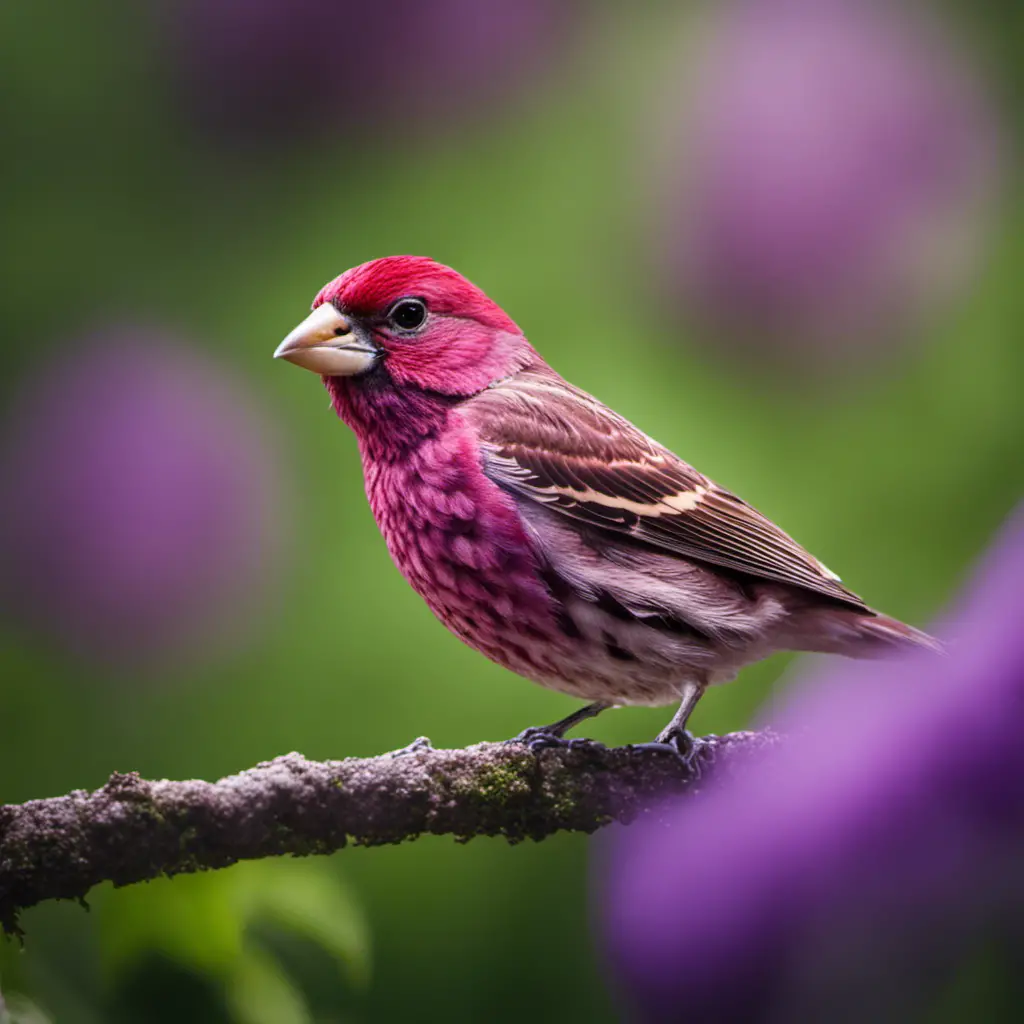
One interesting fact about the Purple Finch is that males have a vibrant reddish-purple plumage while females have a more subdued brown coloration.
The Purple Finch (Haemorhous purpureus) is a small songbird found in North America. It has a wide distribution across its range, from Alaska to the southern United States.
The purple finch is known for its distinctive song, which is a series of warbling notes. This species exhibits interesting migration patterns, with individuals breeding in the northern parts of their range and migrating southward during the winter.
During the breeding season, male purple finches engage in elaborate courtship displays to attract females. These displays involve singing, fluffing their feathers, and hopping from branch to branch. Once a pair is formed, the male continues to sing to defend his territory and attract other females.
Overall, the purple finch is a fascinating bird with unique plumage and interesting mating behavior.
Purple Sunbird
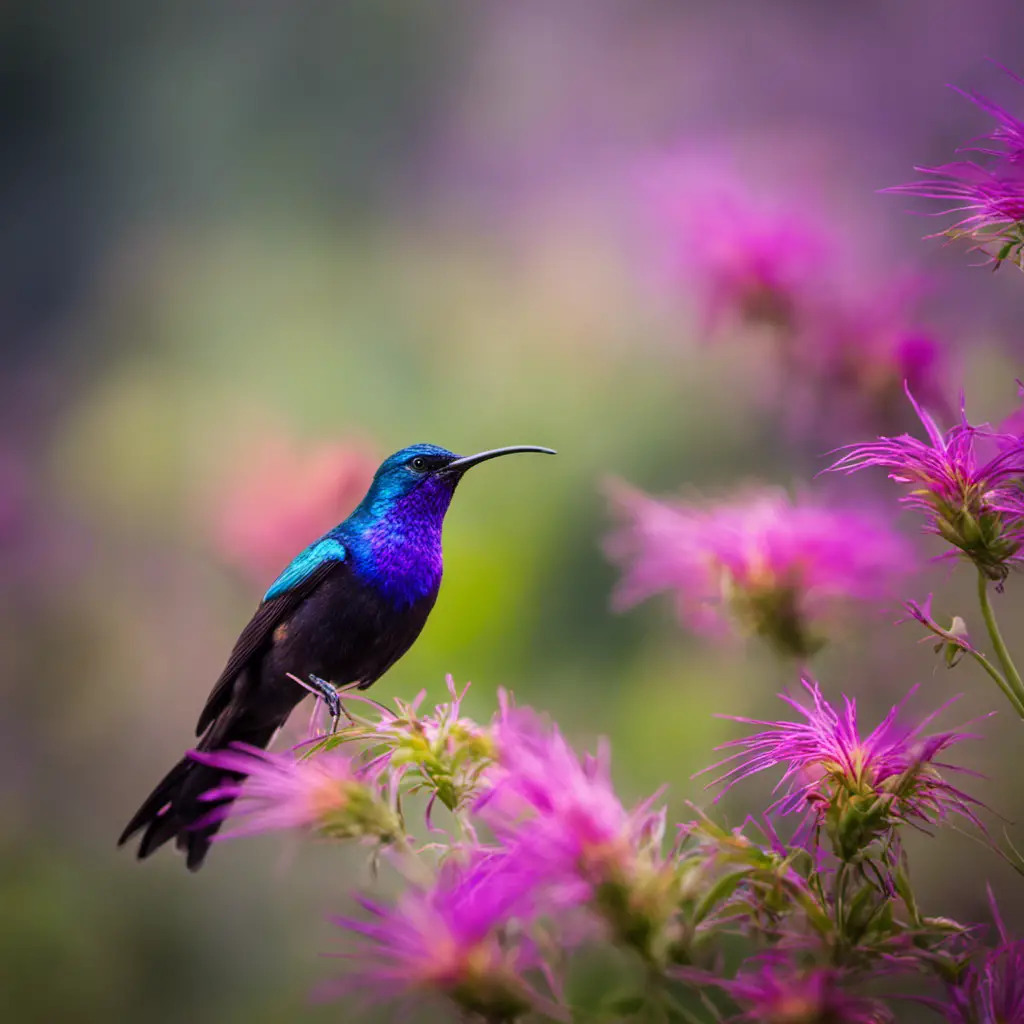
The Purple Sunbird, often referred to as the jewel of the avian world, is a striking bird known for its vibrant colors and unique adaptations. Unlike the Purple Finch, which is found in North America, the Purple Sunbird is native to the tropical regions of Asia. Its preferred habitat includes gardens, forests, and shrublands with ample nectar-rich flowers.
Purple sunbirds exhibit a specialized feeding behavior known as nectarivory, where they primarily feed on nectar from flowers. This makes them important pollinators, as they transfer pollen from one flower to another while feeding. Their vibrant plumage, which includes shades of purple, green, and blue, serves as a visual attraction for potential mates. Additionally, purple sunbirds have long, curved bills that are perfectly adapted for extracting nectar from flowers.
Their habitat and diet have a significant impact on the ecosystems they inhabit, as they help facilitate the reproduction of flowering plants through pollination.
Purple Heron
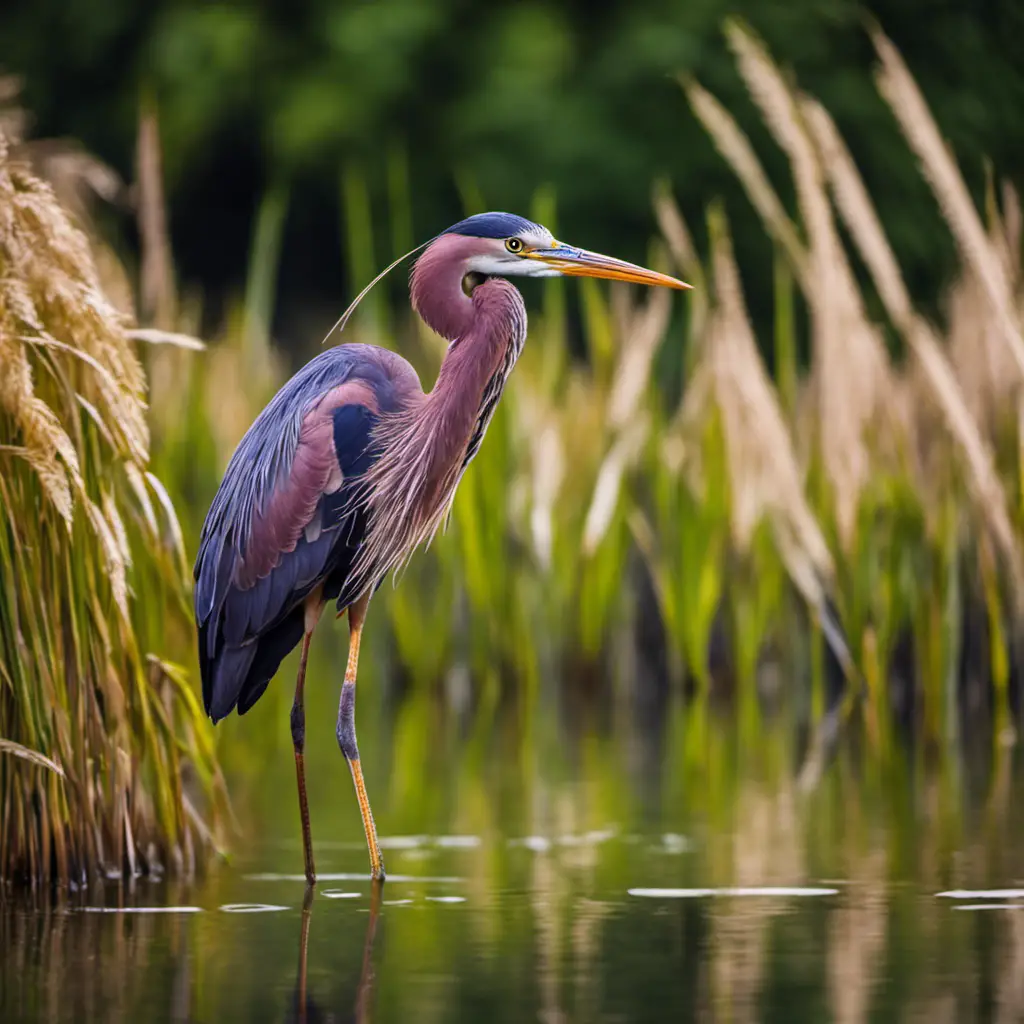
The Purple Heron, known for its distinctive plumage and long, slender neck, is a wading bird that can be found in wetland habitats across Europe and Asia. This elegant bird is known for its graceful flight and its ability to navigate through dense vegetation. The Purple Heron exhibits interesting migration patterns and breeding habits, which have been the subject of scientific study.
Migration patterns of the Purple Heron vary depending on the region. In Europe, these birds are mainly migratory, spending the breeding season in wetlands and then migrating to warmer areas during winter. On the other hand, Asian populations of Purple Herons tend to be more sedentary, with some individuals undertaking short-distance migrations.
When it comes to breeding habits, Purple Herons are colonial nesters, meaning they often breed in large colonies with other herons. These colonies are typically located in dense reedbeds or trees near water. The breeding season usually occurs during the spring and summer months, with both parents participating in nest-building and incubation of the eggs.
Overall, the Purple Heron is a fascinating bird with intriguing migration patterns and breeding habits. Understanding these behaviors is crucial for the conservation and management of their wetland habitats.
| Migration Patterns | Breeding Habits |
|---|---|
| Vary by region | Colonial nesters |
| Migratory in Europe, sedentary in Asia | Breed in large colonies |
| Long-distance migrations in some populations | Nest in dense reedbeds or trees |
| Winter in warmer areas | Both parents participate in nest-building and incubation |
| Important for conservation and habitat management | Breeding season in spring and summer |
Purple-throated Carib
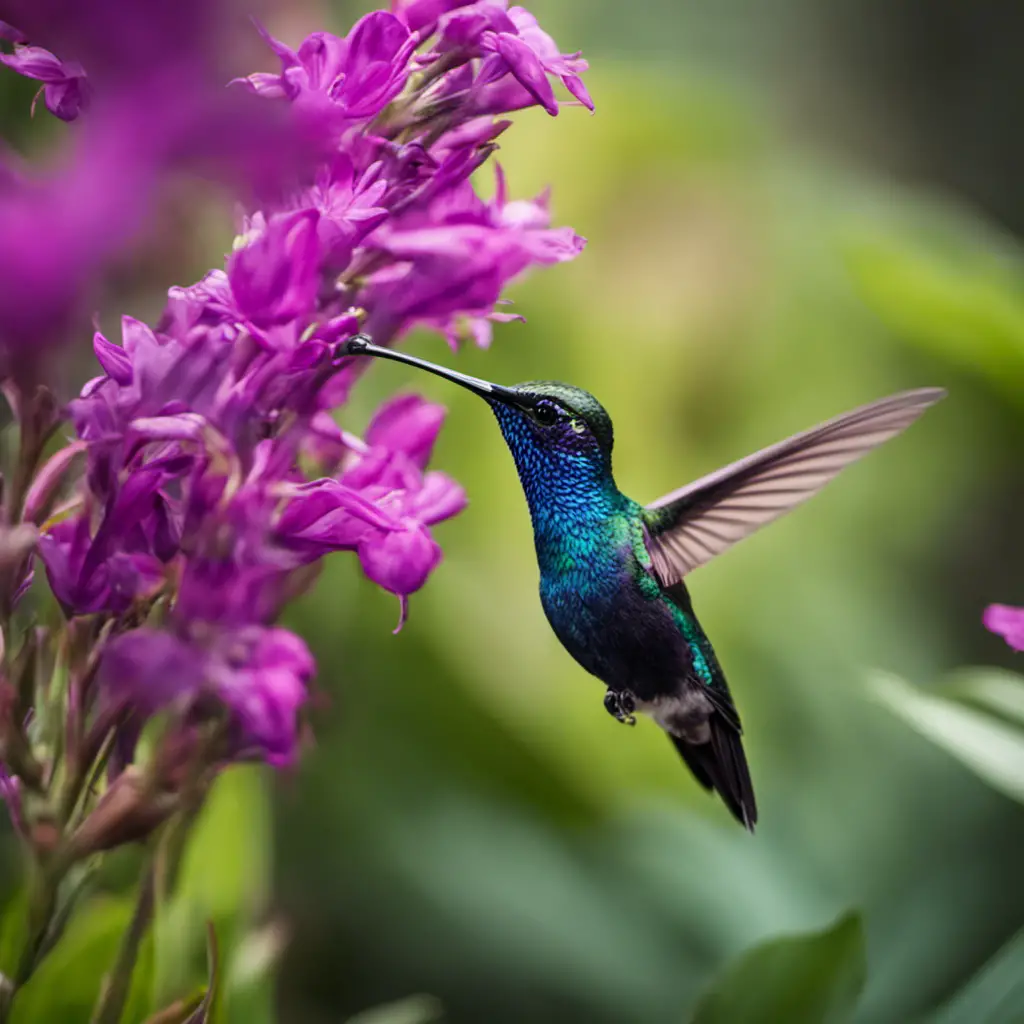
The Purple-throated Carib, a hummingbird species native to the Caribbean, exhibits vibrant plumage and a specialized long beak for sipping nectar from flowers. This small bird is known for its iridescent purple throat, which gives it its name.
The conservation efforts for the Purple-throated Carib have been focused on protecting its habitat and raising awareness about the threats it faces. Loss of habitat due to deforestation and urbanization is a major concern for this species. Additionally, climate change and the disruption of its migration patterns pose significant challenges to its survival.
To ensure the long-term conservation of the Purple-throated Carib, it is important to address these threats and implement measures to protect its habitat and promote sustainable practices.
American Purple Gallinule
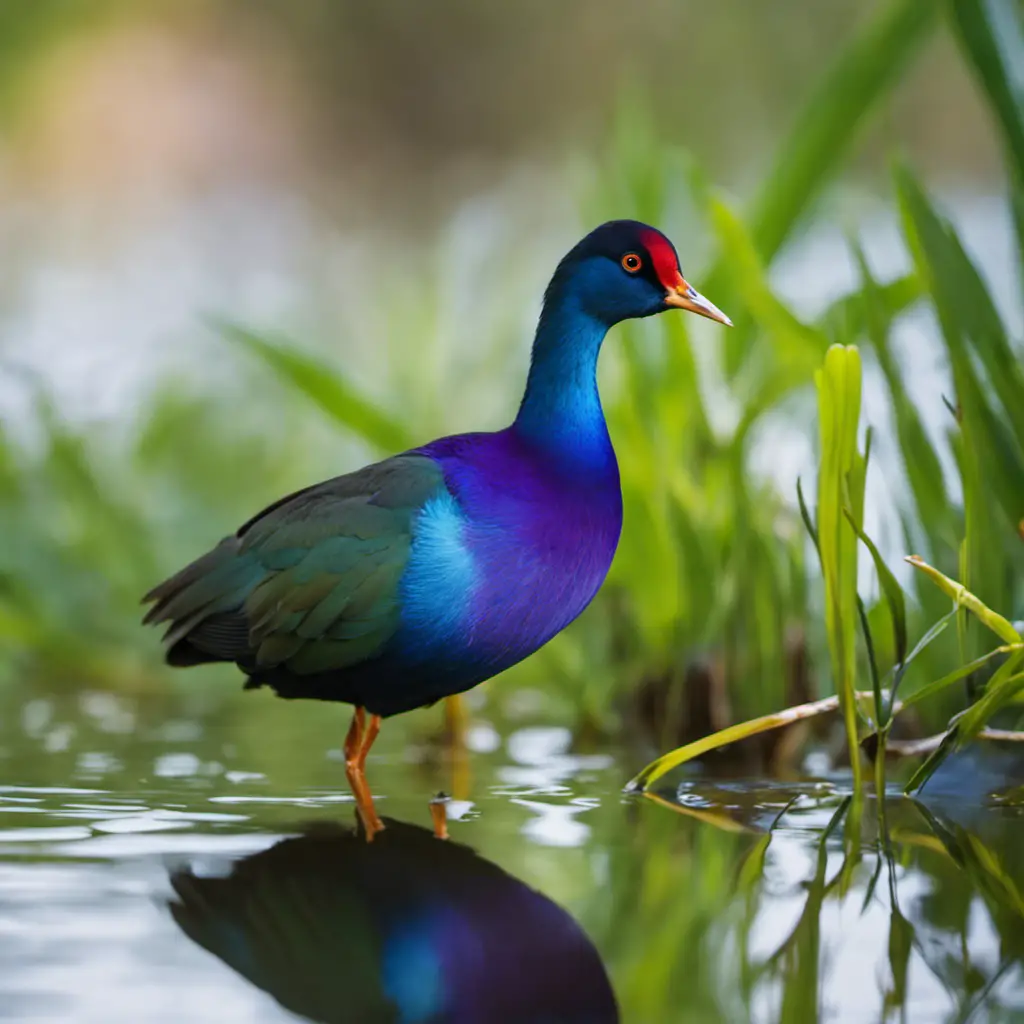
An increasing number of American Purple Gallinules have been observed in wetland habitats, indicating a potential population growth and expansion of this species.
The American Purple Gallinule (Porphyrio martinicus) is a medium-sized bird found primarily in the southeastern United States and parts of Central and South America. This species is known for its vibrant purple-blue plumage, red beak, and long yellow legs.
American Purple Gallinules inhabit freshwater marshes, swamps, and wetlands, where they forage for aquatic vegetation, insects, and small vertebrates. They are also skilled swimmers and can walk on floating vegetation using their long toes.
Despite their adaptability and abundance in some areas, American Purple Gallinules face a number of threats, including habitat loss, pollution, and predation by introduced species.
Conservation efforts are underway to protect wetland habitats and raise awareness about the importance of preserving these unique birds and their ecosystems.
Purple-backed Thornbill
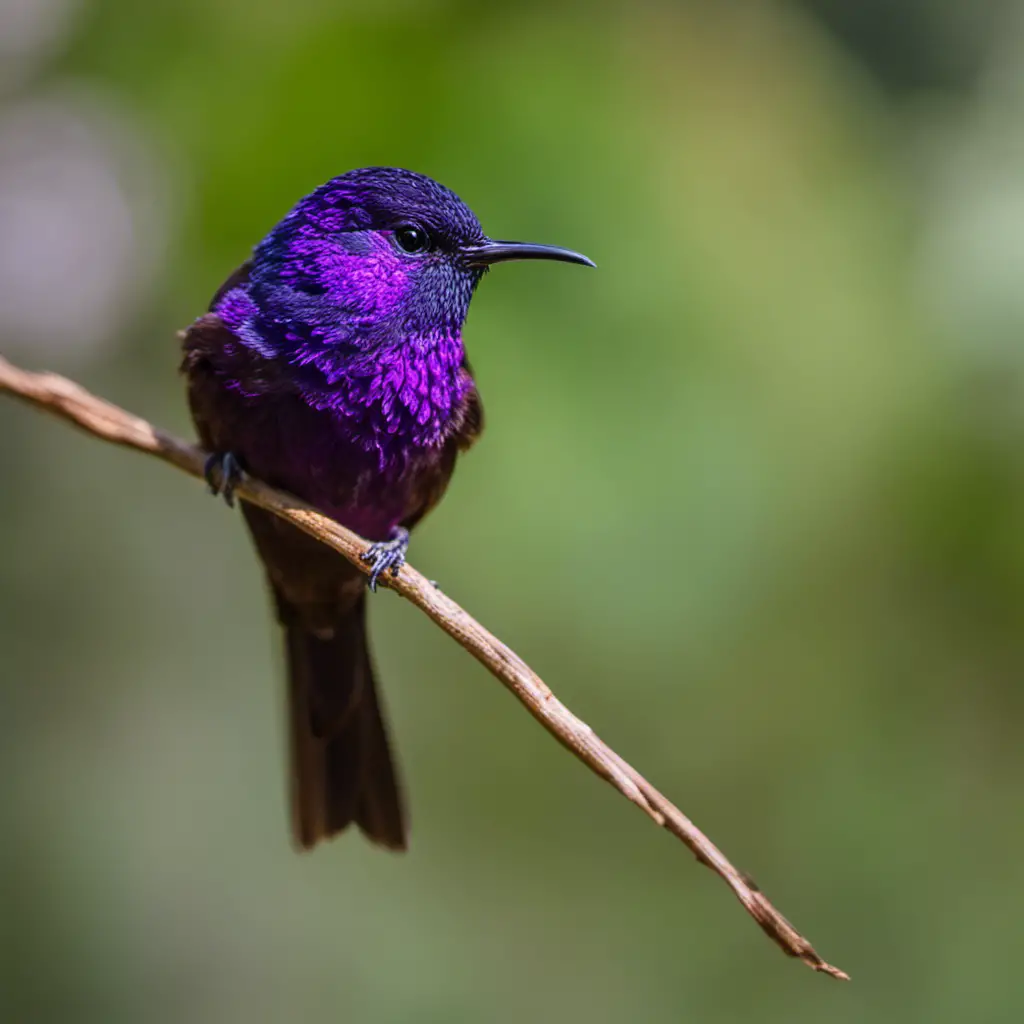
Although relatively small, purple-backed thornbills play a vital role in pollination and seed dispersal within their native habitats. These birds are primarily found in the montane forests of southeastern Australia. They have adapted to this environment by possessing a curved bill that allows them to extract nectar from flowers and a brush-like tongue that aids in feeding on pollen.
Habitat and behavior:
- Purple-backed thornbills prefer moist, dense forests with a mix of shrubs and trees.
- They are highly active and agile, often seen foraging in the understory and mid-canopy.
- These birds form small family groups and exhibit cooperative breeding behavior.
Conservation status and threats:
- The purple-backed thornbill is currently listed as a species of Least Concern by the IUCN.
- However, habitat loss due to deforestation is a significant threat to their population.
- Climate change and the spread of invasive species also pose potential risks to their survival.
Varied Bunting
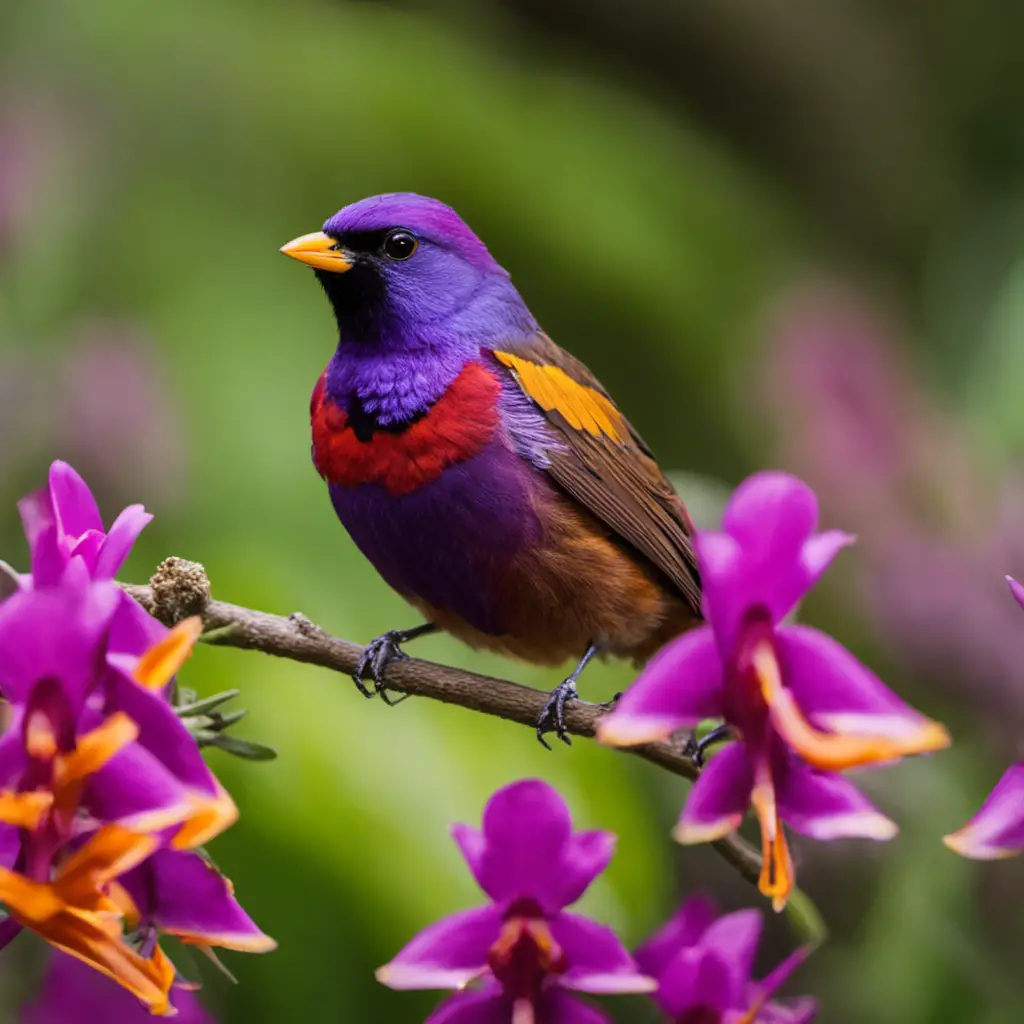
Regarding the current discussion topic of Varied Bunting, these small passerine birds are known for their vibrant plumage and are frequently spotted in the southwestern United States and northern Mexico. The Varied Bunting (Passerina versicolor) belongs to the Cardinalidae family and is one of the many varieties of purple buntings found in North America. Males of this species display a striking combination of blue, red, and orange feathers, while females exhibit more subdued colors with a greenish-brown plumage.
When it comes to their migration patterns, Varied Buntings are considered partial migrants. While some individuals remain in their breeding grounds year-round, others undertake seasonal movements. During the breeding season, these birds can be found in the oak and pine woodlands of their range, where they build cup-shaped nests and lay their eggs. As the weather turns colder, some Varied Buntings migrate southward to Mexico, where they spend the winter months in shrubby habitats.
Understanding the migration patterns and different color variations within the Varied Bunting population is crucial for conservation efforts and provides valuable insights into the ecology of these beautiful birds.
Costa’s Hummingbird
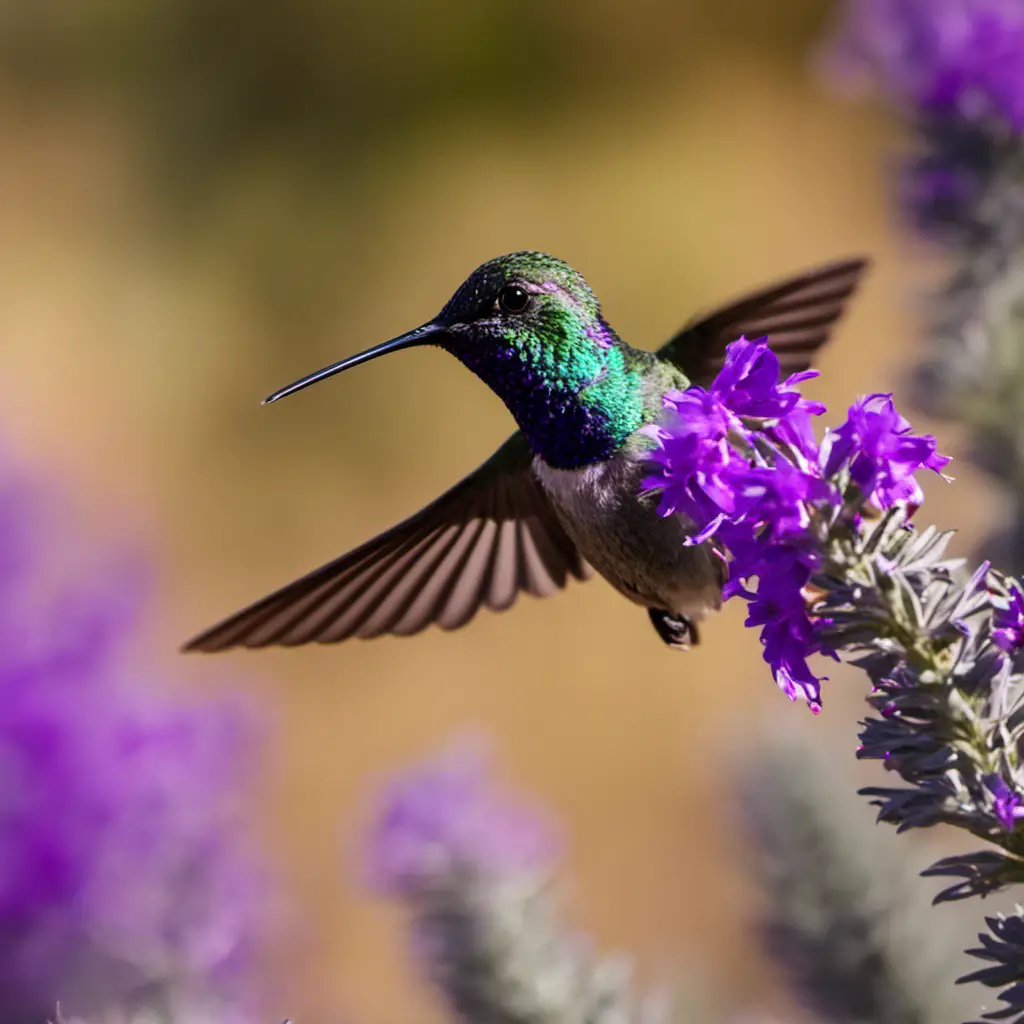
The Costa’s Hummingbird is a small bird found in the southwestern United States and northern Mexico, and it is known for its vibrant iridescent plumage. This species has several unique adaptations that allow it to thrive in its arid habitat.
Firstly, Costa’s Hummingbirds have elongated bills that enable them to reach nectar from the long tubular flowers found in their environment. Additionally, their wings are specially adapted for hovering flight, allowing them to remain stationary while they feed. Lastly, these hummingbirds have the ability to enter a state of torpor, where their metabolic rate decreases significantly to conserve energy during periods of food scarcity or cold temperatures.
Conservation efforts for the Costa’s Hummingbird primarily focus on preserving its habitat. This includes protecting and restoring native vegetation, as well as creating corridors for migration and dispersal. Additionally, efforts are being made to raise awareness about the importance of planting native plants that provide food and shelter for these hummingbirds.
Purple Sandpiper
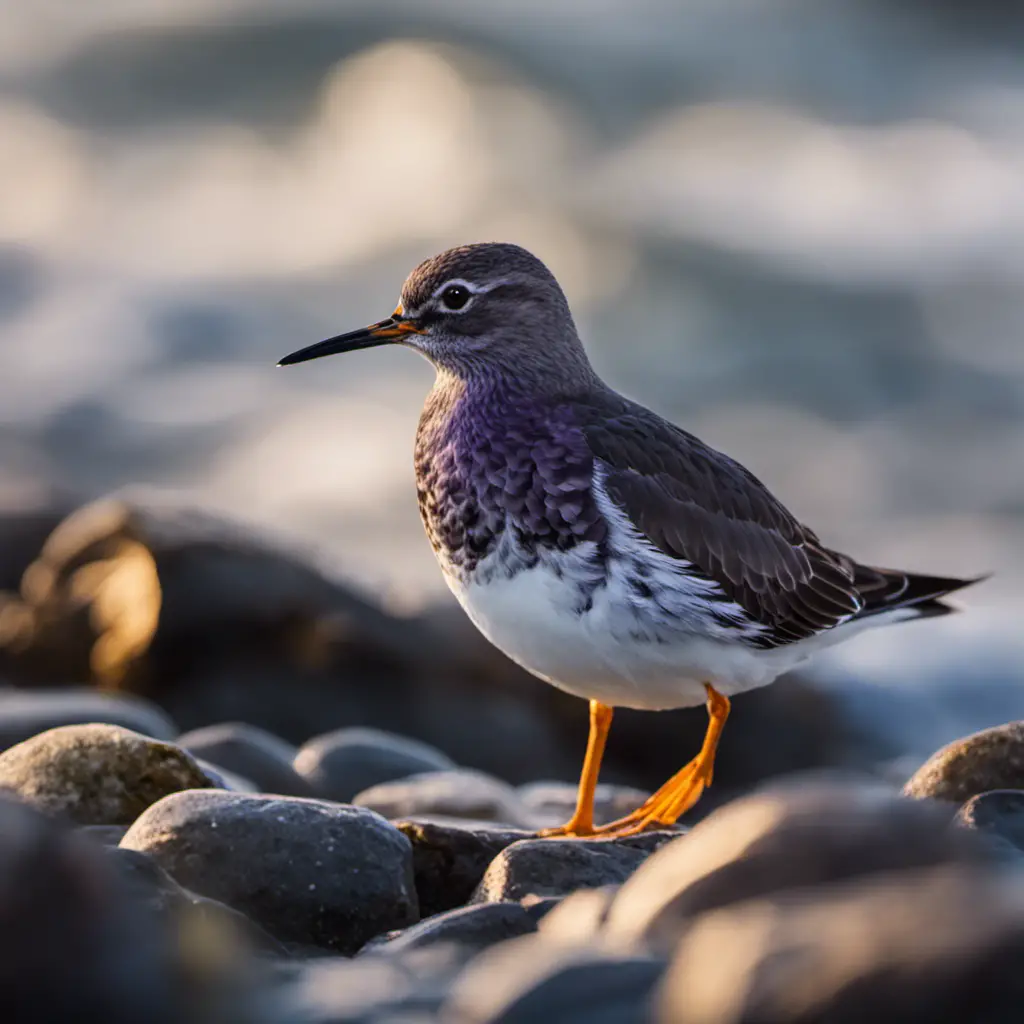
With its distinctive purple plumage, the Purple Sandpiper is a migratory bird that can be found along rocky coastlines during the winter months. This species of bird, scientifically known as Calidris maritima, is known for its unique characteristics that set it apart from other bird species. To better understand these unique characteristics, a comparison table has been provided below:
| Unique Characteristics of Purple Sandpipers |
|---|
| 1. Distinctive purple plumage |
| 2. Ability to withstand harsh coastal climates |
| 3. Migratory behavior |
| 4. Preference for rocky coastlines |
| 5. Adaptation to feeding on marine invertebrates |
Purple sandpiper conservation is an important topic of discussion as this species faces threats such as habitat loss and disturbance. Efforts are being made to protect their coastal habitats and raise awareness about the importance of conservation. Understanding the unique characteristics of purple sandpipers compared to other bird species can aid in developing effective conservation strategies for their long-term survival.
Purple-naped Lory
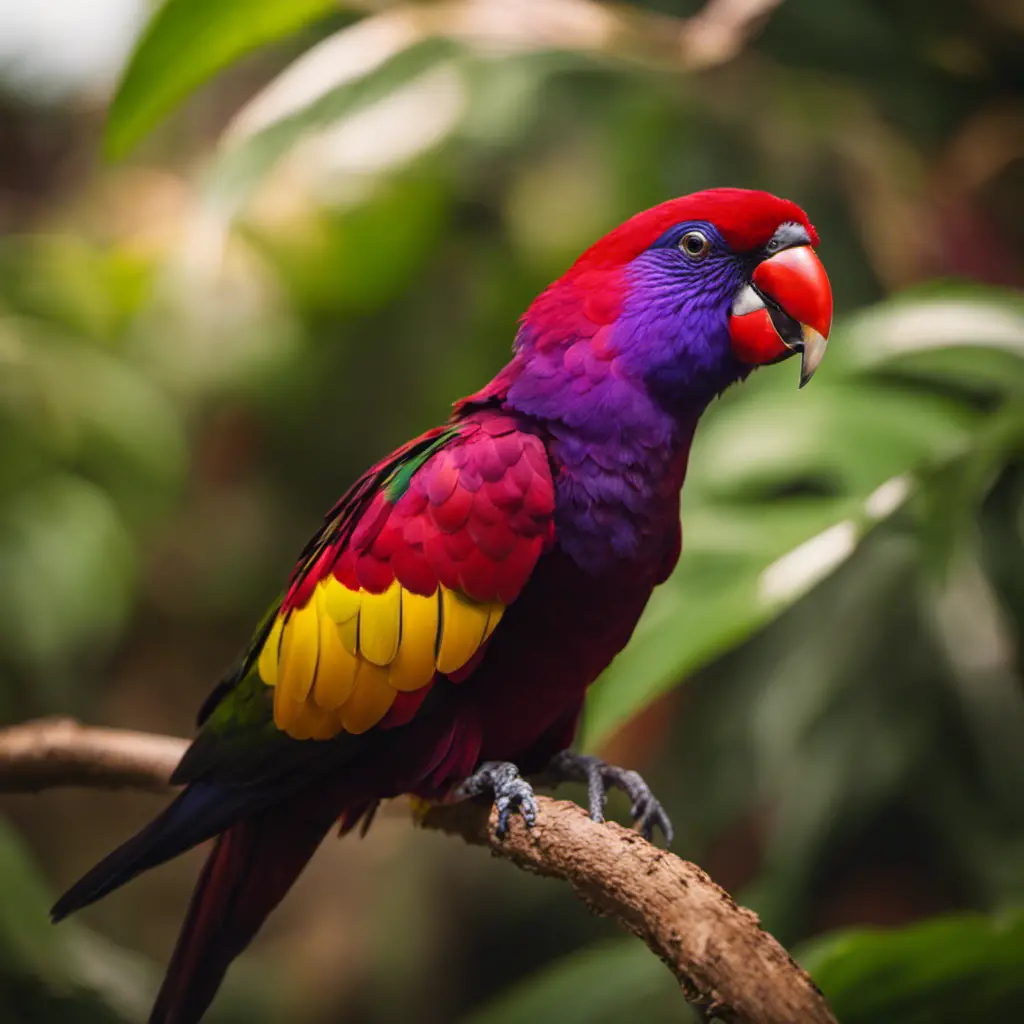
The conservation efforts for the Purple-naped Lory require a comprehensive understanding of its habitat requirements and population dynamics. This species is native to the rainforests of New Guinea and nearby islands, where it primarily inhabits lowland and montane forests. It is known for its vibrant plumage, with a purple nape and bright red feathers on its chest.
To effectively conserve the Purple-naped Lory, the following factors need to be considered:
Habitat preservation: Protecting and maintaining the natural rainforest habitat of the Purple-naped Lory is crucial for its survival. This includes preventing deforestation, illegal logging, and land conversion for agriculture or urbanization.
Population monitoring: Regular monitoring of the Purple-naped Lory populations is essential to track their numbers and assess any changes in their distribution and abundance. This information helps in implementing targeted conservation measures.
Conservation education: Raising awareness among local communities and stakeholders about the importance of the Purple-naped Lory and its habitat is vital. Education programs can help promote sustainable practices and reduce threats to this species.
Purple-bibbed Whitetip
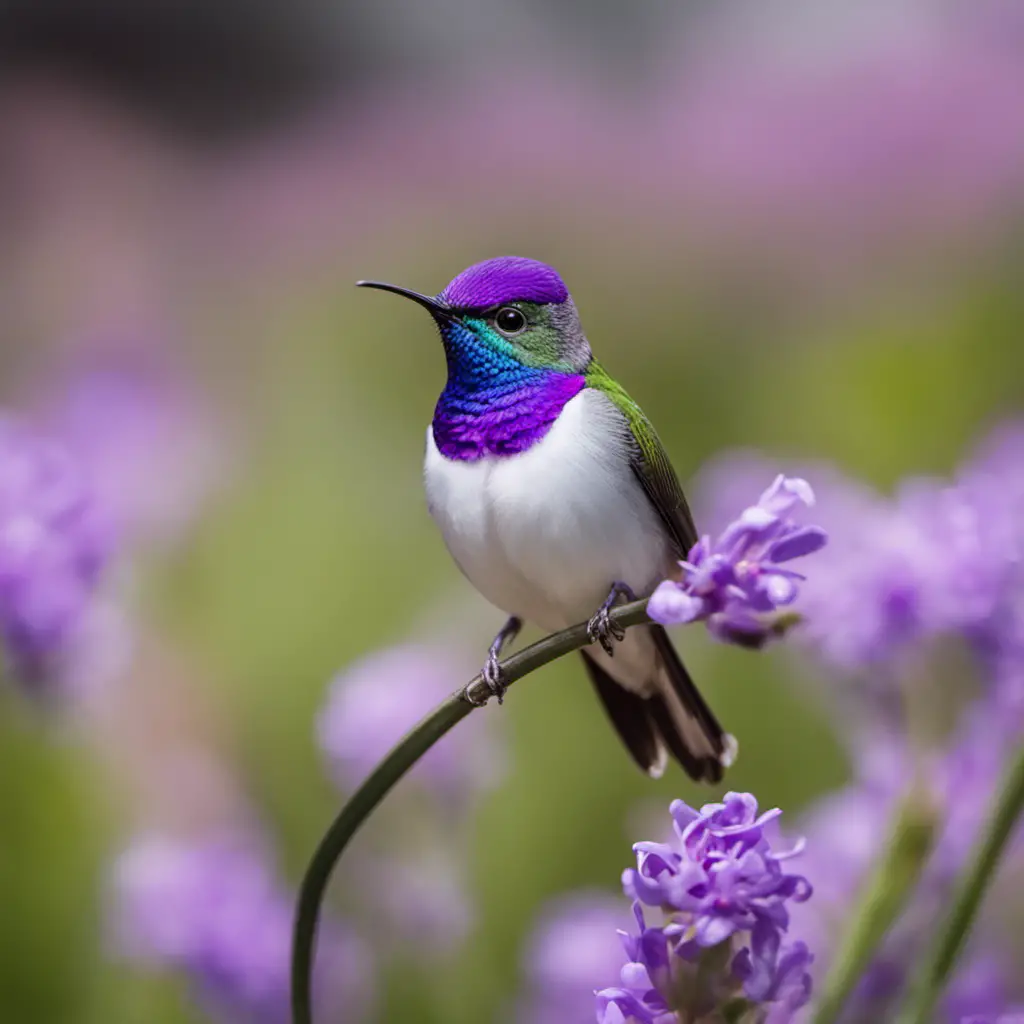
Rarely seen, the Purple-bibbed Whitetip is a small bird native to the cloud forests of Central and South America. It is known for its distinctive purple bib. This unique purple bird species is characterized by its vibrant plumage, with the male exhibiting a brighter purple coloration compared to the female.
The purple bib is believed to play a role in attracting mates and establishing territory. Conservation efforts for the Purple-bibbed Whitetip focus on protecting its fragile cloud forest habitat from deforestation and illegal hunting.
The significance of purple in bird plumage lies in its rarity in the natural world, making it an eye-catching and potentially advantageous trait for attracting mates and deterring predators. Further research is needed to fully understand the evolutionary advantages that purple plumage may provide to the Purple-bibbed Whitetip and other bird species.
Purple-headed Lorikeet
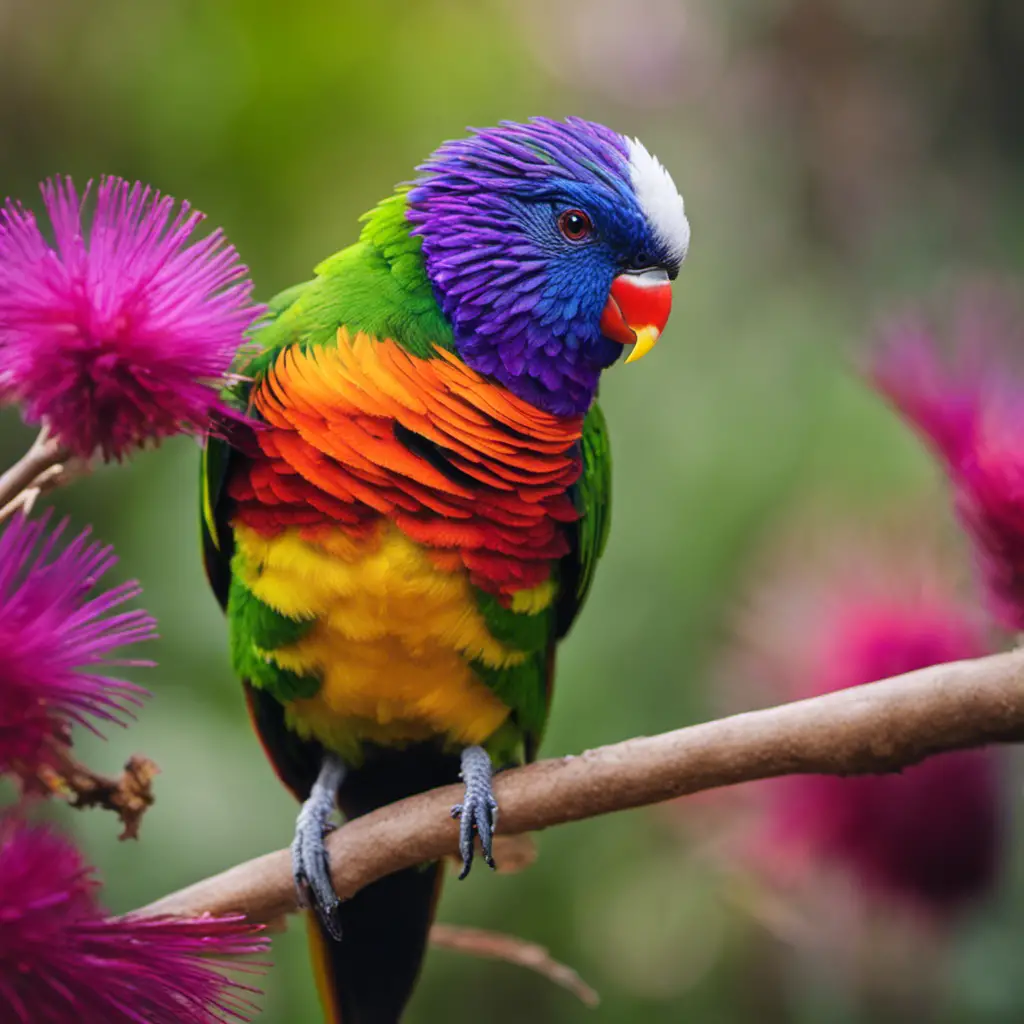
Purple-headed Lorikeet is a vibrant and colorful bird species found in the rainforests of Australia and Indonesia. These unique birds are known for their striking purple heads, which contrast beautifully with their green bodies.
Here are some interesting facts about the habitat and behavior of purple-headed lorikeets:
Habitat: Purple-headed lorikeets primarily inhabit the dense rainforests of Australia and Indonesia. They are commonly found in the canopy layer, where they feed on nectar from various flowering trees and plants.
Feeding Behavior: These lorikeets have a specialized brush-like tongue that allows them to extract nectar from flowers. They also consume fruits, pollen, and seeds. Their vibrant plumage helps them blend in with the colorful flowers they feed on.
Social Behavior: Purple-headed lorikeets are highly social birds and are often seen in small flocks. They communicate through a variety of vocalizations, including screeches and whistles. During breeding season, they form monogamous pairs and build nests in tree hollows.
Purple-bellied Parrotlet
Native to the Amazon rainforest, the vibrant plumage of the Purple-bellied Parrotlet allows it to blend seamlessly among the lush green foliage while foraging for fruits and seeds.
The Purple-bellied Parrotlet (Touit purpuratus) is a small parrot species with a unique purple belly, which sets it apart from other parrots in its genus. These birds measure around 15 centimeters in length and weigh approximately 40 grams.
The purple coloration on their bellies is striking and serves as a form of camouflage within the dense vegetation of their habitat. However, the Purple-bellied Parrotlet faces threats due to deforestation and illegal trapping for the pet trade.
Efforts are being made to protect its habitat and raise awareness about the importance of conservation. Conservation organizations are working closely with local communities to ensure the survival of this beautiful species and the preservation of the Amazon rainforest.
Frequently Asked Questions
Are Purple Birds a Common Species or Are They Rare?
Purple birds, specifically the question of whether they are a common species or rare, can be examined through the lens of purple bird sightings. This analysis will help determine if purple birds are a myth or a reality.
What Is the Typical Habitat of Purple Birds?
The typical habitat of purple birds is influenced by several factors, including their diet and natural predators. Understanding their ecological requirements can help scientists and conservationists in ensuring the preservation of these unique avian species.
Do Purple Birds Migrate or Are They Year-Round Residents?
Migration patterns and population size are important factors to consider when studying bird species. Understanding whether purple birds migrate or are year-round residents can provide valuable insights into their behavior and ecology.
Are Purple Birds Known for Any Unique Behaviors or Traits?
Purple birds are known for their unique mating rituals and the role of color in attracting mates. Their behaviors and traits set them apart from other species, making them fascinating subjects of study in the field of ornithology.
Are There Any Conservation Efforts in Place to Protect Purple Bird Populations?
Conservation efforts are essential to protect bird populations and maintain biodiversity. Community engagement plays a crucial role in these efforts by raising awareness, promoting habitat preservation, and implementing sustainable practices.
Conclusion
In conclusion, purple birds are a diverse group of avian species that exhibit various shades and patterns of purple plumage. These include the Purple Martin, Purple Honeycreeper, Violet-backed Starling, Purple-breasted Cotinga, Purple Gallinule, Purple-naped Lory, Purple-bibbed Whitetip, Purple-headed Lorikeet, and Purple-bellied Parrotlet.
The presence of purple pigmentation in their feathers serves various purposes, such as attracting mates, camouflage, and species recognition.
Further research is needed to fully understand the evolutionary significance and ecological roles of purple coloration in birds.

An avid ornithologist, zoologist and biologist with an unwavering passion for birds and wild animals.
Dr. Wilson’s journey in ornithology began in childhood and led him to obtain a Ph.D. in Ornithology from the prestigious Avian Research Institute. He has worked closely with renowned experts in the field and conducted extensive research and field studies globally.

